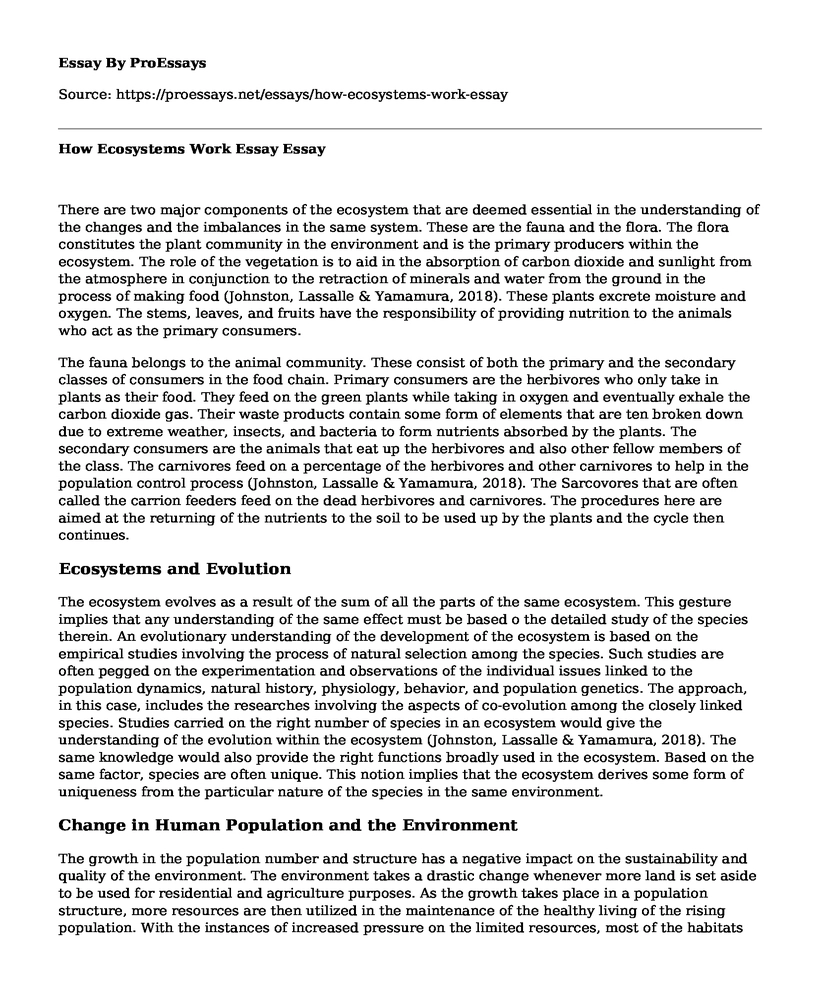There are two major components of the ecosystem that are deemed essential in the understanding of the changes and the imbalances in the same system. These are the fauna and the flora. The flora constitutes the plant community in the environment and is the primary producers within the ecosystem. The role of the vegetation is to aid in the absorption of carbon dioxide and sunlight from the atmosphere in conjunction to the retraction of minerals and water from the ground in the process of making food (Johnston, Lassalle & Yamamura, 2018). These plants excrete moisture and oxygen. The stems, leaves, and fruits have the responsibility of providing nutrition to the animals who act as the primary consumers.
The fauna belongs to the animal community. These consist of both the primary and the secondary classes of consumers in the food chain. Primary consumers are the herbivores who only take in plants as their food. They feed on the green plants while taking in oxygen and eventually exhale the carbon dioxide gas. Their waste products contain some form of elements that are ten broken down due to extreme weather, insects, and bacteria to form nutrients absorbed by the plants. The secondary consumers are the animals that eat up the herbivores and also other fellow members of the class. The carnivores feed on a percentage of the herbivores and other carnivores to help in the population control process (Johnston, Lassalle & Yamamura, 2018). The Sarcovores that are often called the carrion feeders feed on the dead herbivores and carnivores. The procedures here are aimed at the returning of the nutrients to the soil to be used up by the plants and the cycle then continues.
Ecosystems and Evolution
The ecosystem evolves as a result of the sum of all the parts of the same ecosystem. This gesture implies that any understanding of the same effect must be based o the detailed study of the species therein. An evolutionary understanding of the development of the ecosystem is based on the empirical studies involving the process of natural selection among the species. Such studies are often pegged on the experimentation and observations of the individual issues linked to the population dynamics, natural history, physiology, behavior, and population genetics. The approach, in this case, includes the researches involving the aspects of co-evolution among the closely linked species. Studies carried on the right number of species in an ecosystem would give the understanding of the evolution within the ecosystem (Johnston, Lassalle & Yamamura, 2018). The same knowledge would also provide the right functions broadly used in the ecosystem. Based on the same factor, species are often unique. This notion implies that the ecosystem derives some form of uniqueness from the particular nature of the species in the same environment.
Change in Human Population and the Environment
The growth in the population number and structure has a negative impact on the sustainability and quality of the environment. The environment takes a drastic change whenever more land is set aside to be used for residential and agriculture purposes. As the growth takes place in a population structure, more resources are then utilized in the maintenance of the healthy living of the rising population. With the instances of increased pressure on the limited resources, most of the habitats are often destroyed (Johnston, Lassalle & Yamamura, 2018). Humans tend to utilize more resources and the rate at which the environments replenish the same supplies is never commensurate to the scale of destruction.
References
Johnston, A., Lassalle, P., & Yamamura, S. (2018). Re-conceptualizing entrepreneurial ecosystems: a theoretical exploration of evolution over space and time. Geography, Open Innovation and Entrepreneurship, 221.
Cite this page
How Ecosystems Work Essay. (2022, Jul 03). Retrieved from https://proessays.net/essays/how-ecosystems-work-essay
If you are the original author of this essay and no longer wish to have it published on the ProEssays website, please click below to request its removal:
- Khoisan of South Africa
- Course Work Example on Hormones
- The Size Range and Shape of the Volcano Type
- Essay Example on Deep Water Horizon Disaster: The Deadly Oil Spill of 2010
- Essay Example on Zoos and Aquariums: Protecting Animals and Improving Lives
- Essay on U.S. CAFE Standards: Reducing Pollution & Increasing Fuel Economy
- Pre-Service Teacher Mathematics: Enhancing Learning, Engagement & Knowledge - Essay Sample







